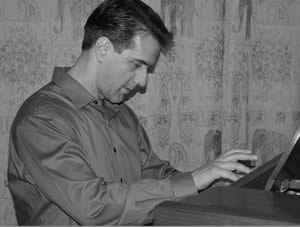In some concerts, Bach’s concerto for two violins is the featured work. In some concerts, Mendelssohn’s octet for strings is the featured work. At the A.J. Fletcher Recital Hall at East Carolina University in mid-February, a lucky audience was treated to both works in the same program, and the result was splendid. As part of the Four Seasons Chamber Music Festival, artistic director Ara Gregorian has recently expanded the season to include two “Next Generation” programs, in which current ECU string students, a graduate of the schools’ string music program, ECU faculty members and a visiting guest performer join forces for an afternoon of music-making, usually consisting of movements from chamber works and one work played in its entirety.
Using the talents of American-born, Finnish-reared violinist Elina Vähälä, ECU alumna Elizabeth York (now a doctoral student at SUNY-Stony Brook) and several faculty members and students, Gregorian fashioned a program of both charm and substance, mixing Mozart and Brahms in with the Bach concerto and Mendelssohn octet. For appetizers, the players offered the opening allegro movement from Mozart’s third string quintet (in C, K. 513), the scherzo movement from Brahms’ string sextet in B-flat, Op. 18, and the second and third movements from Brahms’ piano quintet in F-minor, Op. 34.
Calling the works appetizers, by the way, is not intended to slight either the music or the effort, because all three performances had much to commend. (If the selections seem familiar in the context of a Four Seasons setting, Gregorian programmed the allegro movement of the Brahms piano quintet and the allegro movement of the Mendelssohn octet in the November “Next Generation” concert. The entire piano quintet was part of a 2008 concert.)
The Mozart allegro showed beauty, elegance and delicacy, with Gregorian in the first violinist’s chair adding just the right light touch in the exposed lines. ECU faculty member and frequent Four Seasons cellist Emanuel Gruber had several fine lead lines that added a bit of weight to the music.
The scherzo movement from Brahms’ Op. 18 string sextet is quite the lovely dance, but the more interesting part of this work is the introduction of a second dance-like theme that rises in intensity and ascends in key before settling back into the original motif. And the lovely andante movement and grandly energetic scherzo movement from the Brahms piano quintet in F-minor, Op. 34, received a fine reading, especially with the addition of ECU keyboard faculty member Keiko Sekino. Gruber provided an elegant cello sound to both Brahms pieces, violist Melissa Reardon from the ECU faculty offered much warmth, and Ms. Vähälä’s lead violin was steady throughout.
As frequently as one might hear recorded versions of Bach’s Concerto for Two Violins in D-minor, S.2043, full appreciation of the piece and its intricate interweaving of the two violin parts comes best when seeing it performed live. Gregorian and Ms. Vähälä played as if on a single instrument, with one violin’s melody line seamlessly leading into the other’s line, one line seamlessly echoing the other, and one line seamlessly resolving the other’s opening statement — a true musical dialogue of the highest order. This was especially true in the famous second largo movement, surely one of Bach’s most beautiful melodies. For this piece, the soloists were joined by a 17-member chamber orchestra composed of students, faculty and Elizabeth York. Everyone seemed to have a good time with the jolly opening vivace movement, playing the spirited score precisely (and, like the Orpheus Chamber Ensemble, without a conductor), and they brought the piece to a stirring conclusion, letting out all the stops in the final allegro movement.
The concert could have ended quite nicely with the Bach concerto, but Gregorian and friends were not through, saving perhaps the best for last: Mendelssohn’s String Octet in E-flat, Op. 20, with Gregorian, Ms. Vähälä, Ms. York and ECU junior Caroline Cox on violins; Ms. Reardon and ECU Symphony director Jorge Richter on violas and Gruber and ECU junior Cameron Grimes on cello. Again, much as in the Bach concerto, a listener does not appreciate the lovely interplay of instruments as fully by listening to a recording as by seeing it live. Ms. Vahala was lead violinist throughout much of the piece, having solo passages and exposed lines, and she carried off these sections quite well.
The piece itself is such a wonder, brimming with melody after melody, and filled with a variety of string techniques (pizzicato, spiccato, tremolo) and a diversity of dynamics, and all tied up into such an elegant package of sound. The overall piece has a sunny disposition, although the second andante movement does carry a hint of poignancy, perhaps wistfulness, as it moves up the scale to a lovely close. Watching the musicians skip lightly over their strings in the third scherzo movement was a treat, and the vigorous presto that brought the piece to a close was performed with great verve and skill.











